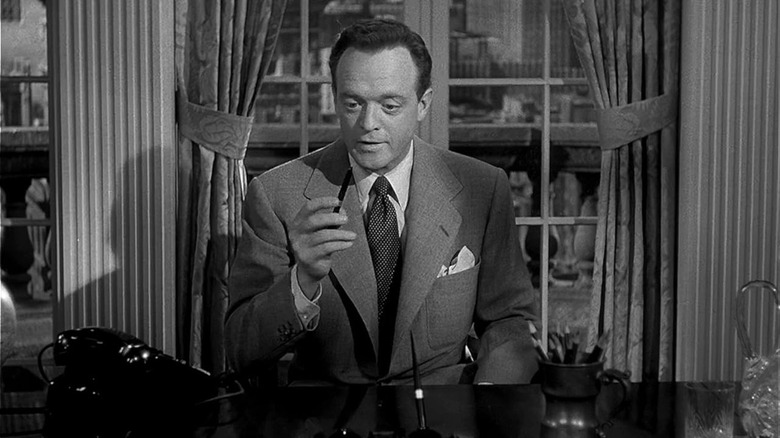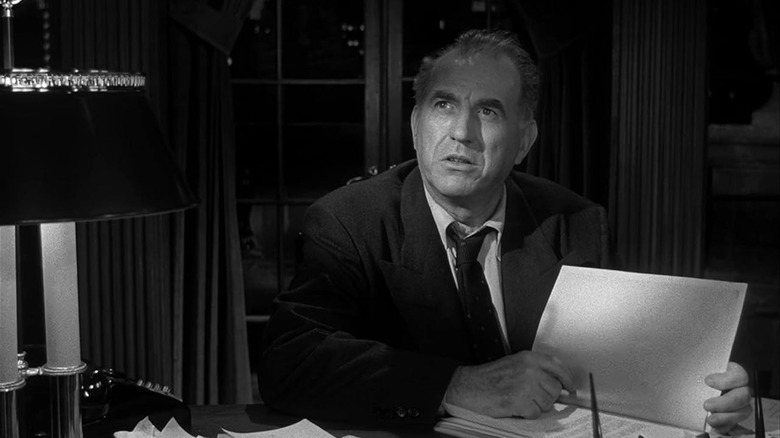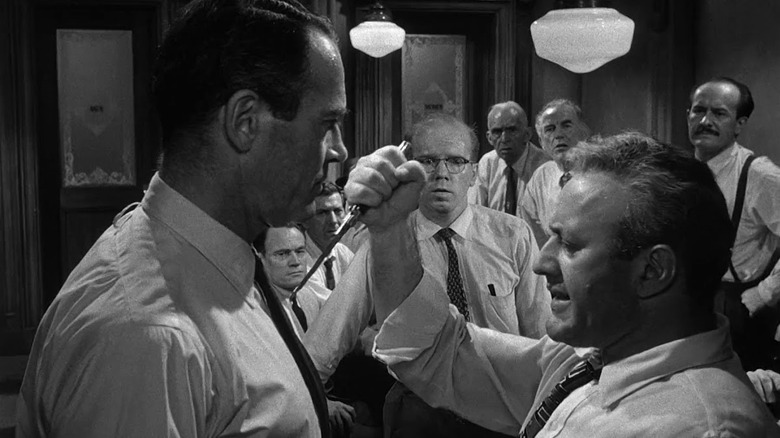How Twilight Zone Creator Rod Serling Shaped Martin Scorsese's Movies
Prior to the inception of "The Twilight Zone," show creator Rod Serling cut his teeth writing numerous TV movies and play adaptations for film and TV alike. His first writing credit came in 1950 for a TV show called "Stars Over Hollywood," an anthology series. Serling continued to pay his dues, penning scripts for "Hollywood Opening Night," "Hallmark Hall of Fame," "Suspense," and "Ponds Theater." TV movies of this sort were more common in the early 1950s than many modern viewers might realize. It's comforting to know that an important television visionary like Serling also had to struggle through a few writer-for-hire jobs before creating one of the most important TV shows of all time.
One of those gigs was an eighth-season episode of "Kraft Television Theater" in 1955 for which Serling wrote a drama called "Patterns." "Patterns" was about a soulless CEO (Everett Sloane) who tried to elbow out an experienced older employee of his (Ed Begley) to make way for a more ambitious, hungrier young buck (Richard Kiley). The Sloane character does everything he can to humiliate the Begley character, eventually leading to his fatal heart attack. The Kiley character is shocked by the ruthlessness of the corporate world, but Sloane convinces him to stay on board. Serling turned the "Patterns" episode into a feature film the next year, as seen pictured above. Fielder Cook, who helmed the TV episode, also directed that version. Kiley was replaced by actor Van Heflin.
It seems that a young Martin Scorsese, when he was still only a teenager, managed to catch the TV version of "Patterns" and was deeply influenced by it. The director said as much in an interview with GQ where he looked back over his career and pondered the state of the modern film industry.
The Patterns of Wall Street
Scorsese remembers "Patterns" very well, as well as the general skepticism many artists had for the rise of corporate U.S. culture in the 1950s. He explained:
"I also became very influenced by the TV show that Rod Serling wrote called 'Patterns,' that was then made into a film. And in fact, in the film 'Patterns' with Van Heflin, he walks into the lobby of this new building, he's going to his job for the first time. This is the period of 'Executive Suite,' which also is excellent. Those two pictures about American corporate life — American corporate wars, so to speak — made a major impression on me when I was a kid."
Robert Wise's "Executive Suite," starring William Holden, was released in May of 1954.
Scorsese clearly had developed a healthy suspicion of corporate office life, seeing a lot of money-focused desk-dwellers as being morally empty. Scorsese's views would surface noisily in his 2013 film "The Wolf of Wall Street," the true story of stock market a-hole Jordan Belfort. Scorsese argued out loud that stock traders and their ilk only want wealth for the express purpose of freeing themselves from conventional morality.
Because of the thematic association he made with "Patterns," Scorsese even shot a "Wolf" scene in the same lobby where the "Patterns" movie was filmed. The scene where a young, innocent Belfort (Leonardo DiCaprio) is optimistically going to his first job matches a scene with Van Heflin from nearly 60 years prior. This may not have been recognized by anyone other than the most passionate film fans, but it was clever that Scorsese should make that connection.
Scorsese, one might say, has Rod Serling to thank for his views of the U.S.
The real U.S.
For the director, films like "Patterns" revealed a new truth about the country he lived in. The U.S., he saw, was filled with spite. Scorsese also mentioned that Sidney Lumet's film "12 Angry Men," which didn't come out until 1957, revealed a lot to his young eyes. Those movies disillusioned him ... exhilaratingly. Marty felt like he had found actual reality for the first time. He began to see different flavors of U.S. aggression, a cathartic feeling for a teen:
"[T]he way those men tore at each other, different from '12 Angry Men,' which also was very revelatory, because that was the first time I saw what America could be."
In brief, the GQ article summed up, the U.S. could be cold, greedy, and cruel. It could be driven by venal impulses, not noble ones. When one is a cynical teenager, already frustrated by adult systems, these kinds of eye-opening moments can be everything. "Now I'm talking about a person," Scorsese said, "who's 11, 12, 14. It's very formative years." Indeed, what are some of your favorite movies? How many of them did you see when you were between 11 and 14? I'm willing to bet it's a lot.
Scorsese rarely makes optimistic films, and he tends to turn his camera on angry, aggressive men, many of them mean, criminal, callow, or sadistic. Some critics have said that Scorsese's exploration of morally bankrupt characters could conceivably be confused with the advocacy of moral bankruptcy. Perhaps watching "Patterns" and fully digesting Serling's view of the corporate U.S. in the 1950s will shed some light onto Scorsese's works and how they function not as celebrations of bleakness but deeply passionate criticisms.
Human beings, if they really put their minds to it, can do terrible, terrible things to one another.


